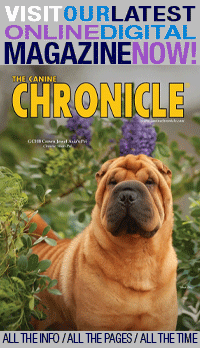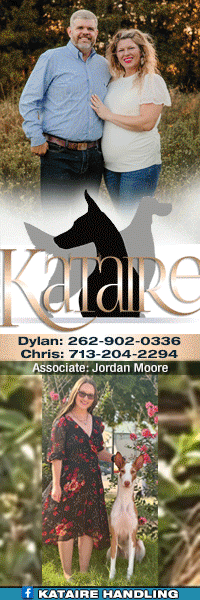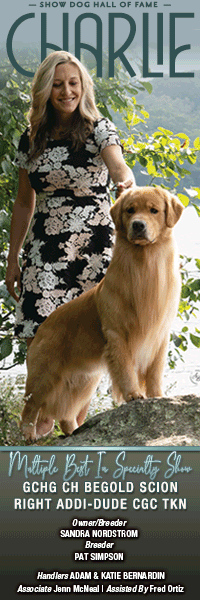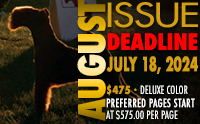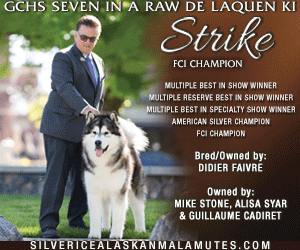The Affenpinscher – A Historical Perspective
From the archives of The Canine Chronicle, May, 2013
By Amy Fernandez
In 1950 Arthur Frederick Jones profiled the Affenpinscher for the AKC Gazette. He had been there since 1926 and served as editor since 1941. In other words, he had watched the dog business long and hard for most of his life. His article was prompted by an encouraging spike in Affenpinscher registrations after a decade of inactivity. His introduction noted that the breed had been “handicapped by inaccurate publicity” since its arrival in America. We may need to brace ourselves for another round of that. Banana Joe’s historic Westminster win is bound to trigger new interest in this fascinating breed. So, let’s set the record straight right now.
The first Affenpinschers were imported to America in 1935 by Mrs. Bessie Mally of Cicero, Illinois to found her Zwergteufel (Dwarf Devil) kennel. History has preserved scant information about her, especially her motivation to establish this rare German breed in America. She was in her mid-30s, and the Affenpinscher was experiencing an unprecedented resurgence in its homeland. She was undoubtedly committed to the project. Transporting dogs from Germany to America was no walk in the park. They came by steamship to New York and traveled on to Chicago by rail express. She also had excellent connections over there because she acquired top quality stock.

That part of the story is unusual, but it pales in comparison to AKC’s readiness to admit this rare breed to its studbook. But that’s exactly what happened September 15, 1936. At that time, AKC had no established criteria for recognizing new breeds. These decisions pretty much depended on the mood of the board – and who was doing the asking. The Affenpinscher was represented by a single breeding program in this country. But it had supporters within the fancy, and they couldn’t get more high profile than Evalyn Walsh McLean and Henrietta Proctor Donnell Reilly.
Evalyn Walsh McLean contributed only one litter to the Affenpinscher’s future, but she garnered priceless publicity for it. This stunningly beautiful heiress was the era’s ultimate socialite. The paparazzi reported every detail of her life. When she entertained, the guest lists included Hollywood celebrities, Washington power brokers, and European royalty. Her clothes set fashion trends and her dazzling jewelry collection included the 45 carat Hope Diamond. Her canine pack included Poodles, Saint Bernards, Great Danes, Silky Terriers, Chihuahuas, and Brussels Griffons. Affenpinschers were the perfect addition to this exotic mix. And yes, they were photographed posed with the jewels.
Henrietta Proctor Donnell Reilly was internationally recognized as an authority on Toy breeds, and a founding member and first and president of the New York-based Progressive Dog Club. She is best remembered for her contribution to Chihuahuas and Min Pins but she also campaigned English Toy Spaniels, Brussels Griffons, and Poodles. Her Etty Haven in Larchmont, New York exemplified the era’s luxurious show kennels. It generally housed 100 dogs, representing top winners in 10-20 different breeds. Along with Toys she campaigned Whippets, Borzoi, Bedlingtons, Cockers, Bull Terriers, German Shepherds, Miniature Schnauzers, Irish Setters, St. Bernards, Boston Terriers, and Skipperkes. She purchased and campaigned several Zwergteufel Affenpinschers from Mally, and also imported two prominent European winners, Everl von der Franziskusklause and Nolli von Anwander.
These names unquestionably added clout to the Affenpinscher cause, but AKC’s surprising decision seemed justified at that time. Based on the roaring success of other German breeds like Dachshunds and German Shepherds, the Affenpinscher seemed destined for popularity in America. When they began appearing at major AKC shows, Jones notes that the public was captivated. “At the time the rotogravure sections and the newsreels gave wide attention to the ‘monkey dog’ …but no one explained why it was so called.” So far, so good.
In 1937 nine Affenpinschers were registered placing it 86th among AKC’s 105 breeds. It subsequently experienced five encouraging years of growth. Another 14 dogs and 13 bitches were registered. However, Mally was the only active breeder and she registered her last litter in October, 1940. This small group of closely bred dogs represented
 the entire American gene pool when WWII prevented additional importation from Germany. AKC didn’t record another Affenpinscher registration for nine years.
the entire American gene pool when WWII prevented additional importation from Germany. AKC didn’t record another Affenpinscher registration for nine years.
The brief public appearance of the “rare monkey terrier” sparked curiosity and exacerbated misperceptions that had surrounded the breed for centuries. In his article, Jones announced his intention to clear away the fog. That must have been welcome news to the loyal fanciers struggling to keep the breed alive. But they were used to smoke and mirrors. Throughout its history, the Affenpinscher had been revived, revamped, rejected, reexamined, redefined, and come close to extinction more than once.
Experts hotly debated its origin for decades. Jones explained its relationship to the Miniature Schnauzer and Min Pin, but even this expert was way out of his league theorizing on this subject. Admitting that “its terrier background cannot be denied,” he speculated that its distinctive standoff coat probably came from the Poodle or Spitz, and the flat face could have only come from “Der Mops.” He was far from the only authority to get the facts completely wrong.
Although pinschers were ubiquitous to Europe, they existed as all purpose farm dogs, well under the radar of official historians. Like other working breeds, numerous variations were developed regionally, known by many names. The most plausible explanation for the name pinscher suggests that it originated as a mispronunciation of Rattenfanger (rat catcher), or Bentchur, a colloquial name for a variety found throughout southern Germany. Both of these names appeared in Johann Wilhelm Baumeister’s 1832 book on native German breeds. Within 20 years, pinscher entered the common lexicon. C.F.H. Weiss’ 1852 German translation of William Youatt’s The Dog described several pinscher breeds, and categorized them as such.
Pinscher became the accepted name for this branch of the canine clan, but no one could reach a consensus regarding their ancestry and origin. The dog world finally got onboard with the scientific determination endorsed by several German and Swiss zoologists such as Ludwig Rutimeyer,( 1825-1895), H.G Reichenbach (1824-1889), and Theodor Studer, (1845-1922).

Their findings were based on a fortuitous ecological event in 1854. The water level in the Swiss Jura suddenly dropped, revealing thousands of well-preserved prehistoric fossils submerged in the peat layers of the mountain lakes. This unprecedented discovery received plenty of media coverage over the next few years as the ancestors of several domestic species were identified in the cache.
Ancient dog relics unearthed at the site were dated from 3000 B.C. More importantly, they provided evidence of the domestication process over the course of two thousand years. The skulls demonstrated a progression from the primitive Stone Age Canis familiaris pallustris into three distinct types including the ancestors of Europe’s Spitz and Pinscher breeds. This prehistoric Torfspitz type was widespread throughout present-day Switzerland, Austria and Germany. Studer’s research was subsequently published in a report entitled Contributions to the History of Our Dog Breeds. It helped to catalyze German efforts to document native breeds in the late nineteenth century and became the basis of their official opinion on Affenpinscher origins. But it didn’t really clarify the relationship between the many pinscher types that existed by then.
Wirehaired Pinschers were first exhibited at a show in Hanover, Germany in 1879. Their appearance prompted an article by R. von Schmiedeber in the July 1879 issue of Der Hund. It addressed the unavoidable question of “what the hell is a pinscher.” This excerpt shows that the pinscher world wasn’t quite ready to provide straightforward answers.
“This question, ‘what is a Pinscher?’ was asked by an English reporter in Hannover, and I answered as well as I could. It would certainly be of great interest that we ourselves should create more and more clarity about the breed that has been included in the show program of Hannover, and an exhaustive answer to this question would be received thankfully. In my humble opinion we can demonstrate a race in our pinscher that is analogous to that of the English terrier. About whether we possess an independent breed of shorthaired pinschers analogous to the so-called Manchester terrier (black and brown markings) or whether the specimens we meet are originally from England, I am still unsure. It does, however appear to be a certainty to me that we cannot deny that the wirehaired pinscher has a highly original and characteristic nature which differs completely from that of all the English terriers and I would almost like to state that we are, in this case, confronted with a specific breed because its characteristics constantly reappear and will not be bastardized in spite of the complete absence of rational breeding.

It would be very desirable that the pinscher breed should be discussed and defined more fully before the next international exhibition so that we may find it represented in greater numbers than was the case in Hannover. There we only found wirehaired pinschers of German breeding but in such a variety of types that the unbiased observer would soon understand how few of the characteristics of this breed really are consistent.”
In 1880, a group of German naturalists, zoologists, and dog experts met in Berlin to lay the groundwork for a unified system of breed designation. They authored early standards for several breeds including Smooth and Wirehaired Pinschers, but that barely scratched the surface. Several smooth and rough coated pinscher breeds were well-established at that time. The country might have become a unified German Empire, but its dog world continued to operate as independent breed clubs in the late nineteenth century. Numerous pinscher and schnauzer breeds, including Affenpinschers, were documented and promoted by small regional clubs throughout the country.
A few years later, the most important figure in pinscher and schnauzer development appeared on the scene to get this mess under control. Josef Berta began his career as a protégé of Max Hartenstein, one of Saxony’s most high profile breeders . His Plavia kennel was internationally known for pinschers, schnauzers, Great Danes, and French Bulldogs. Berta ultimately inherited Hartenstein’s kennel. His schnauzer, Morro, became the source of his kennel prefix, and he continued Hartenstein’s efforts to champion German breeds.
Berta had the foresight to realize that a united effort offered the best hope to save native pinscher breeds. In 1895 he consolidated these groups into one organization, the Pinscher Klub, based in Cologne. Berta served as president of PK until 1921.

In his preface to the first volume of the PK studbook Berta explained his motives for founding the organization. “When the undersigned in the spring of 1895 advocated the foundation of a pinscher club, there were pitifully few dedicated breeders and aficionados of our worthy native dogs. The schnauzer, the foremost representative of the pinscher family, was a cynologic stepchild and endured a lowly existence compared the aristocratic and highly esteemed foreigners. Lack of planning and confusion ruled the ranks; the observer was not yet greeted by uniformity in his breed, there was no tangible type to enthuse the sportsman to spend his experience and fervor on such a hopeless character.”
The Pinscher Klub’s mission statement to “foster the well-being” of all pinscher types was inevitably influenced by prevailing politics and breed popularity. A few of these breeds disappeared during this era including the Large Affenpinscher. This shaggy, rough coated breed was comparable to a Standard Schnauzer, and it was quite popular throughout the 1880s and ‘90s. But reformist breeders considered it an old fashioned, provincial type and this attitude ultimately led to its extinction. Its little brother, the Zwergaffenpinscher, nearly suffered the same fate.
The parameters of Affenpinscher type were quite nebulous at that time. Several small rough and wirecoated pinschers were lumped together as ratters. No clear distinctions existed to separate them when the Pinscher Klub got on the bandwagon to create the Miniature Schnauzer. In his article, Jones notes that “Old illustrations are especially enlightening for they show how this and related breeds have changed in the course of the years.” He specifically mentioned an 1899 picture of a Zwergschnauzer and emphasizes that the difference between these two breeds was indistinct at that time. That’s quite an understatement. A clear separation between Affenpinscher and Miniature Schnauzer wasn’t destined to happen for many years because the same breeders and often the same dogs contributed to both. At one point, the Miniature Schnauzer was christened the Affenschnauzer, and it wasn’t unusual for litters to be dual-registered, as Miniature Schnauzer and Affenpinscher.
Affenpinschers certainly contributed to Miniature Schnauzer development. Unfortunately, its typical domed head, short muzzle and protruding lower jaw were the last things anyone wanted to see in a Schnauzer head. Affenpinscher type became viewed as the undesirable side of the coin, and many breeders were determined to eradicate it through selective breeding. The Affenpinscher still had advocates within the Pinscher Klub, but no one formulated a standard or created guidelines to help breeders define ideal type. Basically, anything that didn’t qualify as a Miniature Schnauzer was labeled as an Affenpinscher by default. This inevitably led to the deterioration of type and quality. The resulting negative impressions about the breed lingered for decades.
Things got worse as emphasis increasingly shifted to Miniature Schnauzer development and this type became generally accepted. Knowledge of correct Affenpinscher type virtually disappeared. In his writings, Berta reveals that it was never his direct intention to eliminate the Affenpinscher in the process of developing the Miniature Schnauzer, but he doubted its survival as a breed.

Breeders and judges were left to improvise their own version of correct Affenpinscher type, which inevitably led to incompetent judging and fads for extreme type. Crossbreeding to Pugs and Brussels Griffons became common, recognizable by shorter, flattened faces and incorrect expression. A 1902 educational brochure jointly published by the Pinscher Klub and Berlin Lapdog Club further contributed to the Affenpinscher’s troubles by dismissing it as “degenerated prototype” and “a shallow breed.”
Needless to say, dedicated breeders became understandably discouraged, even though correct Affenpinscher type had gained some acceptance outside Germany by then. An 1886 account of the Brussels Show in The Field reported that two full classes of Ammfenpinscher or “Monkey Nippers” were shown. Also in 1886, it is reported that “Monkey Terriers” were exhibited at the Royal Aquarium Show in London. They were also entered at Crufts in 1896, the year that the Pinscher Klub was founded.
The Affenpinscher didn’t have much going for it at that point other than its famous willfulness and determination. Regardless of mainstream opinions, this obstinate little creature had no intention of going away. “The nickname seems to go back a long way says Jones and he notes that the breed was designated in the Pinscher Klub’s first studbook as Longhaired Dwarf Terrier (Affenpinscher) Thus the name the breed now carries must have been so widely known in its native country at that time that the keepers of the studbook thought it necessary to identify the new name.” Photographs clearly show that these dogs unmistakably favored Affenpinscher type.
Finally in 1900, at a show in Frankfurt, separate classes were provided for Wirehaired Miniature Pinschers and Affenpinschers. The judge’s report noted the Affenpinscher’s, “pretty, apple-shaped heads, monkey-like expressions, and undershot jaws.” In Volume II of the Pinscher Klub studbook, covering the years 1903-1907, the Affenpinscher was designated as such. This volume listed Affenpinschers in colors of yellow, red, gray, brown, and black. It also documented the breeders and foundation dogs that became the basis of the modern Affenpinscher. These included Mrs. Hermann-Rabausch (Muchen), J. Sacherl (Sahceros). Mrs. Eugenie Mann, Mrs. Schottehamm (Diabolo), Herr Anton Muller, and Countess Schlieben (Ferner).
Two dogs in particular, Zamperl and Flick, became the cornerstone of Affenpinscher development. The Munich-based Ferner bloodline was established in the late 1890s, and it quickly became regarded as the source of modern Affenpinscher type. The kennel’s most outstanding representative, Zamperl, possessed the hard coat, fiery temperament, and roguish expression that breeders dreamed of. He also proved to be a prepotent stud. An unbroken line of important dogs descended from him. His son, Flick, sired Flick Demberger, who sired Peterl V.D. Steinberg who sired, Poldi V. Steinberg. These dogs were instrumental in creating the astounding improvements in Affenpinscher type during this era.
Flick’s owner, Frau Hermann-Raubausch, wife of the Royal Court pianist, staunchly promoted correct Affenpinscher type throughout this dismal period in its history. Born January 7, 1902, Flick was a living reminder of genuine Affenpinscher type as it was rapidly disappearing from the show ring. His career was profiled in the German publication Sports-World. “In the beauty of Flick are all the advantages of the Affenpinscher combined.” Volume III of the PK studbook (1908-1910) listed 18 Affenpinschers, ten bred in Munich, and four in Saxony. The breed wasn’t gaining many followers and most Affenpinscher breeding remained based in Munich. But these registrations confirm that many colors were perpetuated at that time, black, red-yellow, yellow, black-gray, red and black, grayish-black with yellow spots, gray, and red.

Volume IV (1911-1913) showed encouraging progress with 44 Affenpinscher registrations. Once again, Munich breeders led the pack, but breeding programs were established in other parts of Germany, Saxony, Hesse, Baden-Württemberg, Renania and from Munich.Volume V (1914-1917) published during WWI, showed a substantial drop in registrations, only 17 Affenpinschers were recorded but breeders remained active throughout Germany. This was lucky because two Frankfurt breeders kept important bloodlines going and insured the Affenpinscher’s survival during these years.
The most important development during the war years was the Pinscher Klub merger with its former rival, the Beyerischer Schnauzer Klub based in Munich. It had been founded in 1901 and published three volumes of its own studbook. The merger created the Pinscher-Schnauzer Klub (PSK) and it has jointly published a studbook since 1924. After the war, Affenpinscher breeding resumed and several important bloodlines emerged in the following decade.
Eventually Berta reevaluated the wisdom of his hands-off policy. Although it worked out well for the Miniature Schnauzer, he realized that he better use his clout to promote traditional Affenpinscher type before it disappeared completely. Volume I of the PSK (Pinscher-Schnauzer Klub) studbook also contained a description of Affenpinscher characteristics and a clarification of guidelines for breeders compiled with the cooperation of breeders who had successfully perpetuated the “old type.”
This included a detailed description of the teeth and correct shortening and angle of the lower jaw. This had been recognized a crucial Affenpinscher trait but had been subject to massive misinterpretation. The clarification stressed that Affenpinscher expression was achieved through a combination of a protruding lower jaw, and the correct amount of space between the reverse scissors bite which was estimated as “the size of a match”, approximately 1/6 up to 1/8 of an inch. It clearly stated that Griffon or Pug expression was incorrect.
When these detailed guidelines were published, breeders rapidly stabilized the type that we are familiar with today. This further encouraged new interest and new kennels emerged. These included V Landeshutia kennel owned by Geourge Nussbaumer and Amuhle kennel owned by Herr Willibald Umuller; this added up much needed additions to the Affenpinshcer gene pool. The 1923 PSK studbook recorded an astounding 260 Affenpinscher registrations.
By then, breeders were distributed throughout Germany, but Munich remained the country’s Affenpinscher stronghold, and these breeders favored black Affenpinschers. Over the next 20 years, the percentage of black dogs escalated from 40 percent to 90 percent, until the popularity of the black Affenpinschers completely overwhelmed all other colors.
Otherwise, the breed was in relatively good shape until the onset of WWII. The Affenpinscher never really recovered from this setback. Registrations fluctuated from 10 in 1945 to 43 in 1956, and back down to 36 in 1969. The standard was updated in 1956, but this did nothing to correct problems that had crept into the breed by then. Before East and West Germany were reunited in 1989, experimental crossbreedings to Schnauzers were done to prevent the breed from completely dying out in its homeland.
On a more positive note, there were renewed efforts to establish the Affenpinscher in America after the war. Stock imported from Germany came primarily from the same bloodlines that had seeded Bessie Mally’s now extinct Zwergteugel kennel – Anna Katzbicher (Franziskusklause), Josi Greimel (Von Walteufel), and Sixtus Anwander. In 1950, Evelyn Brody established Cedarlawn kennel.  One of her imports, Bud Anwander, became the breed’s first AKC champion, and made history in 1949 as the first Affenpinscher to earn a group placement. Mrs. Walter Kauffman and her daughters also established Walhof kennel in New Jersey during this period. They imported an additional six dogs to expand the gene pool and produced notable winners of the era like Ch. Walhof Ivy. Arthur and Mary Harrington founded Aiff-Airn kennel in Albany, New York with Cedarlawn stock. These three kennels became the foundation to reestablish American Affenpinscher bloodlines.
One of her imports, Bud Anwander, became the breed’s first AKC champion, and made history in 1949 as the first Affenpinscher to earn a group placement. Mrs. Walter Kauffman and her daughters also established Walhof kennel in New Jersey during this period. They imported an additional six dogs to expand the gene pool and produced notable winners of the era like Ch. Walhof Ivy. Arthur and Mary Harrington founded Aiff-Airn kennel in Albany, New York with Cedarlawn stock. These three kennels became the foundation to reestablish American Affenpinscher bloodlines.

Although it was never destined to attain the popularity of some German breeds, the Affenpinscher definitely caught the 1950s wave of interest in purebreds. In 1951, Lucille Meystedt founded Balu Affenpinschers in Rusk, Texas. She was approved to judge most Toy breeds and actively involved with Brussels Griffons, Miniature Pinschers, Pekingese, Italian Greyhounds, and Papillons, and went on to produce 35 homebred Affenpinscher champions. Her most famous dog, Int’l., German, American, Mexican, Canadian, Columbian Ch. Vinzenz V. Greifensse attracted countless new fans to the breed during his extensive show campaign. Meystedt also founded the Affenpinscher Club of America, and was the breed columnist for Popular Dogs for many years.
The Affenpinscher was clearly making progress in 1950 when Jones penned his breed profile. He happily announced that nine registrations had been recorded by AKC that year. He was also keenly aware that misperceptions had derailed the breed more than once. In his article, he stated his hope that Affenpinscher fanciers would dispel longstanding myths surrounding its image as the exotic “monkey terrier.” He advised them to discourage photographers from “only making head studies,” and instead emphasize overall type when educating the public about the breed. “If more people realized how sturdily it is built, more of them would be anxious to own Affenpinschers.”
That is very sound advice, but it’s obvious that the breed’s captivating personality had clinched the deal for him. “Anyone who has ever owned an Affenpinscher speaks in lyrical terms of his intelligence.” Jones was fascinated with its characteristic devilish temperament saying, “The Affenpinscher is only a little fellow but he has so much spirit and courage that he seems like a much larger dog…. he will brook no interference from outsiders and those he feels will violate the peace of his fireside.”
Interest in the breed spiked in the 1950s but it was hardly an easy rise to the top. It definitely suffered from a lack of organized effort to promote the breed and encourage new fanciers. Finally, 30 years after its arrival, the Affenpinscher Club of America was founded in 1965 – largely through the efforts of Lucille Meystedt. Like every other aspect of Affenpinscher history, the club grew slowly. In September, 1976 they held a match show which proved to be a turning point. On May 17, 1986, 21 years after its founding meeting, the AFA held its first AKC approved specialty in conjunction with the Mattiponi Kennel Club. An entry of 39 Affenpinschers turned out for this historic event.
Jones ended his profile by expressing his hope, “that this little mite would someday become the Toy of America.” Arthur Frederick Jones is long gone, but I suspect that he watched and smiled on February 13th when Banana Joe broke through the purebred dog world’s glass ceiling to seize the ultimate prize. Judge Michael Dougherty admitted that Joey demanded the win and he could not be denied, once again proving a point that Affenpinscher lovers have understood for centuries.
AKC Registration Records
AKC registrations demonstrate the Affenpinscher’s slow, steady growth after 1950.
1950-1954 – 37 registrations
1954-1959 – 107 registrations
1960-1969 – 225 registrations
1970-1979 – 293 registrations
1980-1989 – 554 registrations
In 2002 the breed ranked 117th in terms of AKC registrations. By 2007, it had dropped to 125th, and by 2011 it was in 139th place. Last year it moved up a notch to 138th.
Kennel Clubs Replace Private Studbooks
Historically, breeding and documenting purebreds was the private domain of aristocratic families. Many of these studbooks abruptly ended as these ancient families disappeared in the wake of revolutions that swept through Europe in the nineteenth century. The task of maintaining studbook records was transferred to newly founded national kennel clubs. In some cases, this was a little more complicated.
Germany, per se, didn’t exist until a very recent point in the evolution of most of its native breeds. Before Otto von Bismarck (1815-1898) united them as Chancellor of the German Reich, Germany consisted of a conglomeration of independent states, duchies, and principalities. Each had its own unique regional dialects, customs, and dog breeds.
During Bismarck’s tenure as Prime Minister of Prussia, warfare resulted in the annexation Bavaria, Württemberg Baden, and Hesse which became part of the North German Alliance. Established in 1866, it eventually included 17 North German states and became the foundation of the German Empire which emerged in 1870. Unification quickly made Germany the dominant player in Northern Europe’s industrial revolution. Its sizable economic, political, and cultural influence also had a major impact on the nineteenth-century’s evolving dog world.

Short URL: http://caninechronicle.com/?p=21983
Comments are closed
